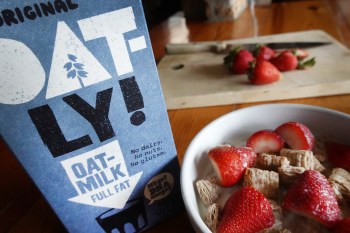Breast milk for sale?
Share Now on:
Breast milk for sale?
Owing to a miscalculation, the cost of Prolacta’s milk was inaccurately stated. The report should have said that Prolacta is seeking to sell its milk at more than a dollar a milliliter — more than 10 times the cost of processed breast milk from HMBANNA banks.
KAI RYSSDAL: Even the companies that make infant formula can’t really argue this one. Mother’s milk is the best thing for babies. But breastfeeding isn’t always as easy as you’d think. Women who can’t — or don’t want to — nurse their babies have some choices. They can buy breast milk online for $2 an ounce, or get it via non-profit milk banks. But, increasingly, the milk could come from businesses that operate on a strictly for-profit basis. Nancy Mullane has more.
NANCY MULLANE: Every morning Carrie Holmberg sits down with the electric breast pump she bought after giving birth to her second daughter. She says she can pump an extra six ounces of her breast milk a day, store it in the freezer and then donate it.
CARRIE HOLMBERG:“It feels good to be giving something my body made to others knowing that they’re getting the best food.”
Holmberg is one of hundreds of women nationwide donating their extra breast milk to one of nine milk banks associated with the non-profit Human Milk Bank Association of North America. Last year, demand for processed breast milk from these banks rose 28%. Pauline Sakamoto is executive director of the Mothers Milk Bank in San Jose, one of the milk banks accepting donations.
PAULINE SAKAMOTO:“You know, they may come in bags, they may come in bottles, they may come in Ziplock baggies.”
Sakamoto is standing in the banks immaculate double-wide trailer. For more than 30 years, she says her staff has collected, tested, pasteurized and delivered safe breast milk to hospitals and parents with babies in need, functioning reliably on a shoestring budget.
SAKAMOTO:“Just the processing, the labor involved, and the cost of the blood tests and the cost of shipping priority overnight . . . about $3 an ounce.”
But HMBANNA Milk Banks are no longer the only milk banks in town. Prolacta Bioscience is the country’s first for-profit processor of donated breast milk. It recently opened a $4 million human milk processing facility near Los Angeles. Elena Medo is Prolacta’s CEO. She says her company hopes to sell its breast milk exclusively to hospitals for $3 a milliliter — ten times the cost of processed breast milk from HMBANNA banks
ELENA MEDO:“There is a difference in philosophical belief in terms of profit or non-profit, but the bottom line is we all are doing the same thing, we all value human milk.
The question is, where does a for-profit corporation with the potential to make millions of dollars on donated breast milk, get the milk? Prolacta is establishing a network of 10 non-profit milk banks based in hospitals and birthing centers across the country. The centers collect and send the breast milk exclusively to Prolacta to be processed and sold to hospitals. But some women who contacted the national milk banks said it wasn’t clear in their literature, on their consent form or on the Web sites that the donated milk would ultimately be sold by Prolacta for a profit. Prolacta’s Elena Medo says the company makes no effort to hide the fact it’s a for-profit concern and, she says, no attempt is made to disguise this from the mothers who donate.
MEDO:“She knows that it definitely will be sold for a profit and so they sign a consent. They are informed when they first call the milk bank. They’re getting a pump, they’re getting some little incentive back, but they are not getting paid for donating their milk.”
While Prolacta isn’t paying the donating mothers for their milk, the company is paying the network of hospitals and birthing centers up to $2 for every ounce of breast milk they procure exclusively for Prolacta. Dr. Nancy Wight is an attending neonatologist at Sharp Mary Birth Hospital for women in San Diego. She says the facilities do get some benefit from the payments made by companies such as Prolacta. But there’s a rub.
NANCY WIGHT:“I think they are setting up a huge collection network. My only concern is are we going to be diverting milk from the existing not-for-profit sector, and I think that’s a possibility.”
As Carrie Holmberg finishes breast feeding her 6-month-old daughter, she says she donates for altruistic reasons.
HOLMBERG:“If I knew a company were profiting from my breast milk, it would make it a business transaction, not one mother supporting another mother.
Prolacta would not release the names of the hospitals buying its processed breast milk, nor say how much it has sold, but says it has the capacity to process more than 10 million ounces of breast milk a year. Last year, HMBANNA milk banks produced three quarters of a million ounces. Whatever the future, whether provided by profit or non-profit milk banks, this is a market that’s not going to dry up.
In San Francisco, I’m Nancy Mullane for Marketplace.
There’s a lot happening in the world. Through it all, Marketplace is here for you.
You rely on Marketplace to break down the world’s events and tell you how it affects you in a fact-based, approachable way. We rely on your financial support to keep making that possible.
Your donation today powers the independent journalism that you rely on. For just $5/month, you can help sustain Marketplace so we can keep reporting on the things that matter to you.

















